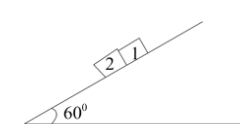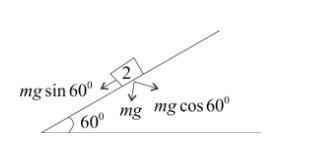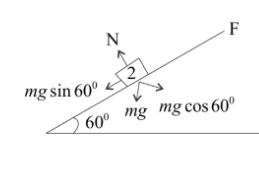
In the figure shown if the friction coefficient of the block $1$ and $2$ with the inclined plane is ${\mu _1} = 0.5$and ${\mu _2} = 0.4$ respectively, then find out the correct statement.
$\left( a \right)$ Both blocks will move together
$\left( b \right)$ Both blocks will move separately
$\left( c \right)$ There is a non-zero contact force between two blocks
$\left( d \right)$ None of these

Answer
219k+ views
Hint So to solve this type of problem it is necessary to draw the free fall diagram and in this question, we will consider both the blocks are independent and then we will find the acceleration for both the blocks by using the formula$a = g\sin \theta - \mu g\cos \theta $.
Formula used
Acceleration for the block will be
$a = g\sin \theta - \mu g\cos \theta $
Here,
$a$, will be the acceleration of the block
$g$, will be the acceleration due to gravity
Complete Step by Step Solution
Let's consider the two blocks $1$ and$2$, both are independent. Since the blocks are independent so their acceleration will also be independent for both of the blocks.
Acceleration for block$1$:

As we know the formula,
${a_1} = g\sin \theta - {\mu _1}g\cos \theta $
Now substitute the values, we get
$ \Rightarrow g\left[ {\dfrac{{\sqrt 3 }}{2} - \dfrac{1}{2} \times \dfrac{1}{2}} \right]$
On solving the above equation, we get
$ \Rightarrow g\left[ {\dfrac{{2\sqrt 3 - 1}}{4}} \right]$
Therefore, $g\left[ {\dfrac{{2\sqrt 3 - 1}}{4}} \right]$ will be the acceleration for the first block.
Similarly,
Acceleration for block$2$:

As we know the formula,
${a_2} = g\sin \theta - {\mu _2}g\cos \theta $
Now substitute the values, we get
$ \Rightarrow g\left[ {\dfrac{{\sqrt 3 }}{2} - \dfrac{2}{5} \times \dfrac{1}{2}} \right]$
On solving the above equation, we get
$ \Rightarrow g\left[ {5\sqrt 3 - 2} \right]$
Therefore, $g\left[ {5\sqrt 3 - 2} \right]$ will be the acceleration for the second block.
So, we see that the acceleration ${a_2}$is greater than the acceleration of ${a_1}$
Therefore, we can say that both the blocks will move separately.
Hence the option $B$will be correct.
Note Acceleration is positive in the “down” direction, where “down” is where the nearest big source of gravity is.
In physics, acceleration is usually expressed as a vector, i.e. a direction and a magnitude. A magnitude is an absolute value, hence always positive.
We could say the object is accelerating negatively in the “up” direction but that’s a muddled way of looking at things. Direction-and-magnitude makes more sense.
Formula used
Acceleration for the block will be
$a = g\sin \theta - \mu g\cos \theta $
Here,
$a$, will be the acceleration of the block
$g$, will be the acceleration due to gravity
Complete Step by Step Solution
Let's consider the two blocks $1$ and$2$, both are independent. Since the blocks are independent so their acceleration will also be independent for both of the blocks.
Acceleration for block$1$:

As we know the formula,
${a_1} = g\sin \theta - {\mu _1}g\cos \theta $
Now substitute the values, we get
$ \Rightarrow g\left[ {\dfrac{{\sqrt 3 }}{2} - \dfrac{1}{2} \times \dfrac{1}{2}} \right]$
On solving the above equation, we get
$ \Rightarrow g\left[ {\dfrac{{2\sqrt 3 - 1}}{4}} \right]$
Therefore, $g\left[ {\dfrac{{2\sqrt 3 - 1}}{4}} \right]$ will be the acceleration for the first block.
Similarly,
Acceleration for block$2$:

As we know the formula,
${a_2} = g\sin \theta - {\mu _2}g\cos \theta $
Now substitute the values, we get
$ \Rightarrow g\left[ {\dfrac{{\sqrt 3 }}{2} - \dfrac{2}{5} \times \dfrac{1}{2}} \right]$
On solving the above equation, we get
$ \Rightarrow g\left[ {5\sqrt 3 - 2} \right]$
Therefore, $g\left[ {5\sqrt 3 - 2} \right]$ will be the acceleration for the second block.
So, we see that the acceleration ${a_2}$is greater than the acceleration of ${a_1}$
Therefore, we can say that both the blocks will move separately.
Hence the option $B$will be correct.
Note Acceleration is positive in the “down” direction, where “down” is where the nearest big source of gravity is.
In physics, acceleration is usually expressed as a vector, i.e. a direction and a magnitude. A magnitude is an absolute value, hence always positive.
We could say the object is accelerating negatively in the “up” direction but that’s a muddled way of looking at things. Direction-and-magnitude makes more sense.
Recently Updated Pages
Two discs which are rotating about their respective class 11 physics JEE_Main

A ladder rests against a frictionless vertical wall class 11 physics JEE_Main

Two simple pendulums of lengths 1 m and 16 m respectively class 11 physics JEE_Main

The slopes of isothermal and adiabatic curves are related class 11 physics JEE_Main

A trolly falling freely on an inclined plane as shown class 11 physics JEE_Main

The masses M1 and M2M2 M1 are released from rest Using class 11 physics JEE_Main

Trending doubts
JEE Main 2026: Application Form Open, Exam Dates, Syllabus, Eligibility & Question Papers

Derivation of Equation of Trajectory Explained for Students

Hybridisation in Chemistry – Concept, Types & Applications

Understanding the Angle of Deviation in a Prism

Understanding Collisions: Types and Examples for Students

Understanding Atomic Structure for Beginners

Other Pages
JEE Advanced Marks vs Ranks 2025: Understanding Category-wise Qualifying Marks and Previous Year Cut-offs

Units And Measurements Class 11 Physics Chapter 1 CBSE Notes - 2025-26

NCERT Solutions For Class 11 Physics Chapter 8 Mechanical Properties Of Solids

Motion in a Straight Line Class 11 Physics Chapter 2 CBSE Notes - 2025-26

NCERT Solutions for Class 11 Physics Chapter 7 Gravitation 2025-26

How to Convert a Galvanometer into an Ammeter or Voltmeter




